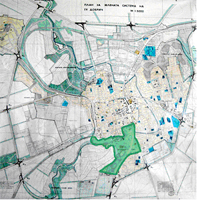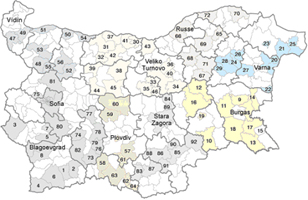 |
 |
 |
 |
 |
 |
 |
 |
 |
 |
 |
 |
Project description
Name of the case study
Regeneration of Dobrich Town Park, Dobrich Municipality
Description of context
The regeneration of Dobrich Town Park was undertaken within the national Beautiful Bulgaria Project (BBP). It was developed after a successful pilot initiative in 1997 (partial financial support provided by EC and a know-how on the collaboration between national and local authorities provided by UNDP. BBP aims at developing innovative policy approach with particular focus on the social impact and at the same time to alleviate neglected urban infrastructure (mainly renovation of historical buildings, squares, parks etc.) in Bulgarian cities and towns.
Description of project - background
National Level
BBP operates essentially in urban centres characterised by high levels of long-term urban unemployment and with neglected urban infrastructure in urgent need of repair. The project provides vocational training in the field of construction for registered long-term unemployed people. They are after that temporarily hired in local Small to Medium Enterprises (SMEs) and contracted by BBP to refurbish buildings, parks and squares using newly acquired skills.
Municipal Level
The Municipality of Dobrich has elaborated a Development Plan for the Green Infrastructure (DPGI) and Regulation for the Implementation and Realisation (RIR) of the Plan in 1999 (fig.2). DPGI identifies the existing green spaces and defines the recreational and ecological requirements to them according to the peculiarities of the landscape, urban and demographic structure in the town. The town is divided in four park regions which are managed by the respective administrative units. As a result, clear and effective organisation is created for the realisation of the DPGI.
However, problems concerning green area maintenance are still persisting including preservation of the vegetation diversity, cleanness, lighting, etc.
Description of project - objectives/aims
National Level
The main targets of BBP are: regeneration of the urban environment, promotion of tourism, provision of an accessible public environment and capacity building at the local level (vocational training in construction and tourism).
BBP supports most of the life-cycle stages of urban environment development – inception, project design, project assessment, implementation (construction) and quality monitoring during the operation (a set of 13 quantitative indicators are included and public opinion inquiries are carried out at the end of each BBP stage).
BBP is well known and generally accepted by local people. A Public Opinion Poll on BBP ( December 2000, GALLUP) reveals that 86 % of all the interviewees in the cities where Beautiful Bulgaria is implemented claim to be aware of both the concept of the project and its results; interviewed citizens see its most important positive effects in: the improvement of the urban environment (71%); revival of the civic pride of the population (47%); conservation of the cultural heritage (61%); generation of temporary jobs for the unemployed (58%).
Municipal Level
Dobrich Town Park Regeneration Project, which gained BBP financial support in 2003, targeted a compact green space linking the town centre with the urban fringe. The park had originated from a small town garden of 2 ha which dated from the beginning of 20th century and nowadays declared a historical monument of landscape heritage. By 1948 it had expanded to 18 ha and the present day total area of 40 ha represents an important factor favourably influencing the local microclimate. However, the area needed an urgent regeneration of horticulture and a new social focus to be defined concerning the effective use and management of the park.

Dobrich town green/blue development scheme with the Town Park included
Description of project - time interval and stages
National Level
BBP has developed in four stages:
• Pilot project named ´Beautiful Sofia´ (1997-1998) - The project was designed to address the problem of unemployment in the city of Sofia. It funded works dedicated to improving the neglected urban fabric. Through them the project generated temporary jobs and historic facades, monuments and parks were refurbished. The pilot project exceeded the initial expectations and was further developed by Beautiful Bulgaria I.
• Beautiful Bulgaria I (1998-1999) - In this stage, five of Bulgaria's largest cities, Sofia, Plovdiv, Varna, Russe and Veliko Turnovo were targeted.They had some of the highest concentrations of unemployment in the country. The main objectives of the project were the generation of urban employment and the improvement of the urban environment in the five cities (including a large number of historical buildings, parks and public squares). Groups of unemployed people in each city were identified, trained and engaged through local sub-contracts in labour intensive public works.
• Beautiful Bulgaria II (1999-2001) – The project included 6 additional cities: Vidin, Stara Zagora, Silistra, Vratza, Yambol and Razgrad. The project was executed by the Ministry of Labour and Social Policy with the support of UNDP and the EU, and was implemented by the 11 target Municipalities.
• Beautiful Bulgaria III (2001-2003) – 42 Bulgarian municipalities joined in the project. This stage focused on the increasing of the tourism attractiveness and potential of the municipalities. Dobrich Municipality gained the grant with its project for the Town Park regeneration.
The BBP project is now in its fourth stage.
Municipal Level
The project realisation of the town park reconstruction started in 2003 and was accomplished in 2004. However the preliminary study and project development needed a period of 10 years. Nowadays (end of 2004) reconstruction continues through the renovation of the underground passage at the main entrance to the park from the pedestrian street linking it with the town centre.
Description of project - financing
National Level
The selected projects are supported according to a co-financed scheme:
• BBP National Budget – 50% of the project budget (labour payment);
• Municipal Budget – 50% of the project budget (expenses for building materials and management).
One of the important BBP targets is the refurbishment of parks, urban green spaces, children's playgrounds, cleaning-up of riverbeds and the construction of eco-trails – together with raising public awareness on the importance of environmental issues.
BBP is also sensitive to traditional gender issues. Traditionally construction and repair works are undertaken by men, the eco-component of the BBP projects provides an employment opportunity for women. The fourth annual application deadline for financing within BBP closed in March 2004.The total number of supported municipalities has risen to over 100.

Municipalities with grants received within the Beautiful Bulgaria Project (up to 2003 the total number was over 100)
Municipal Level
Project financing was provided according the co-financed scheme proposed in the national BBP. See information in 'National Level' financing.
Description of project - other sectors involved
National and municipal levels
Despite the existence of a specific focus (a building, park or square) posed by BBP, the project implementation at the municipal level usually concerns almost all urban infrastructure sectors. A general conclusion concerning the urban green spaces regeneration and based on the experience of BBP could be made – there is a complex interaction (and often a conflict) between the green and the water supply/ sewage systems. The reconstruction of the water and sewage pipes hinders the proper maintenance of green spaces. Conversely - sometimes the tree roots harm the pipes.
Actors involved in the project:
BBP, Dobrich Municipality (Ecology and Green Infrastructure Department), municipal SMEs, unemployed people.
What tools were used to assess sustainability?
Municipal Target Criteria (one of Two-level Target Criteria)
National Target Criteria (one of Two-level Target Criteria)
More information